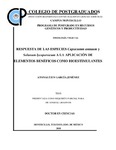| dc.description.abstract | Los elementos benéficos son considerados no esenciales para las plantas, pero a dosis óptimas y aplicados adecuadamente pueden inducir respuestas favorables. El objetivo de esta investigación fue evaluar el efecto de diferentes concentraciones de lantano (La: 0 y 10 µM LaCl3), vanadio (V: 0, 5, 10 y 15 μM NH4VO3) y silicio (Si: 0, 60, 125 y 250 mg L-1 CaSiO₃) sobre el crecimiento y las concentraciones de clorofilas, aminoácidos, proteínas, azúcares y nutrimentos en pimiento (Capsicum annuum) y tomate (Solanum lycopersicum) cultivados en hidroponía. Para La se evaluaron cuatro variedades comerciales de pimiento: Sven, Sympathy, Yolo Wonder y Zidenka. Treinta días después de aplicado el La, la variedad Yolo Wonder prevaleció en altura de planta, número de hojas, número de botones florales y área foliar siendo significativo comparado con el control. A los 15 ddt el La incrementó la concentración de clorofilas y proteínas en las cuatro variedades de estudio; a los 30 ddt el La incrementó la concentración de azúcares. En el estudio con V y Si, se evaluaron plantas de pimiento cv. Mysterio F1 de 37 d de edad. Para el V las evaluaciones se realizaron a los 7, 14, 21 y 28 días después del inicio de tratamientos. La aplicación de 5 μM V incrementó el crecimiento de la planta y aceleró la floración. Del mismo modo, favoreció la concentración de aminoácidos en hojas, así como 5 y 15 μM V en tallos. La mayor concentración de este elemento fue en la raíz. La aplicación de Si, con aplicaciones de 60 y 250 mg L-1, incrementó la concentración de aminoácidos en raíz, y de azúcares en hojas y tallos, con la aplicación de 125 mg L-1 Si. La mayor concentración de Si fue en raíz. En el último ensayo se evaluó el efecto del V en plantas de tomate, encontrando que la altura aumentó con la aplicación de 5 μM y volumen de raíz a los 28 ddt. La aplicación de 5 μM V favoreció los pigmentos fotosintéticos en hojas, y con 15 μM V incrementó en tallos y hojas. La concentración de V en raíz fue superior con 10 μM V. Con esta investigación se concluye que el La, V y Si pueden estimular respuestas en pimiento y tomate, y se plantean como bioestimulantes potenciales con aplicaciones en la agricultura. _______________ RESPONSE OF SPECIES Capsicumm annuum and Solanum lycopersicum TO THE APPLICATION OF BENEFICIAL ELEMENTS AS BIOSTIMULANTS. ABSTRACT: Beneficial elements are considered not essential for the plants, but at optimal doses and properly applied they can induce favorable responses. The objective of this investigation was to evaluate the effect of different concentrations of lanthanum (La: 0 and 10 μM LaCl3), vanadium (V: 0, 5, 10 and 15 μM NH4VO3) and silicon (Si: 0, 60, 125 and 250 mg L-1 CaSiO₃) on growth and concentrations of chlorophylls, amino acids, proteins, sugars and mineral nutrients of pepper (Capsicum annuum) and tomato (Solanum lycopersicum) plants grown in hydroponics. For La, four commercial pepper varieties were evaluated: Sven, Sympathy, Yolo Wonder and Zidenka. In the growth variables at 30 days after treatments (dat) the Yolo Wonder treated with 10 µM La variety prevailed in plant height, number of leaves, number of flower buds and leaf area being significant compared to the control. At 15 dat, the concentration of chlorophylls and proteins in the four varieties treated with La increased; at 30 dat, the application of La increased the concentration of sugars. In the study with V and Si, pepper plants cv. Mysterio F1 of 37 d of age were used. Evaluations were made at 7, 14, 21 and 28 dat. The application of 5 μM V increased the growth of the plant and accelerated flowering. In the same way, it favored the concentration of amino acids in leaves and 5 and 15 μM V in stems. The highest concentration of this element was in roots. The application of Si increased the concentration of amino acids in the root with applications of 60 and 250 mg L-1 Si and sugars with the application of 125 mg L-1 Si in leaves and stems. The highest concentration of this element was at the root. In the last trial the effect of V on tomato plants was evaluated, finding that the height increased with the application of 5 μM and root volume at 28 dat. The application of 5 μM V favored the photosynthetic pigments in leaves, and with 15 μM V increased in stems and leaves. The concentration of V was higher with 10 μM V in root. With this research it is concluded that La, V and Si can stimulate favorable responses in pepper and tomato. Therefore, these elements in this research are emerging as potential biostimulants with applications in agriculture. | es_MX |


